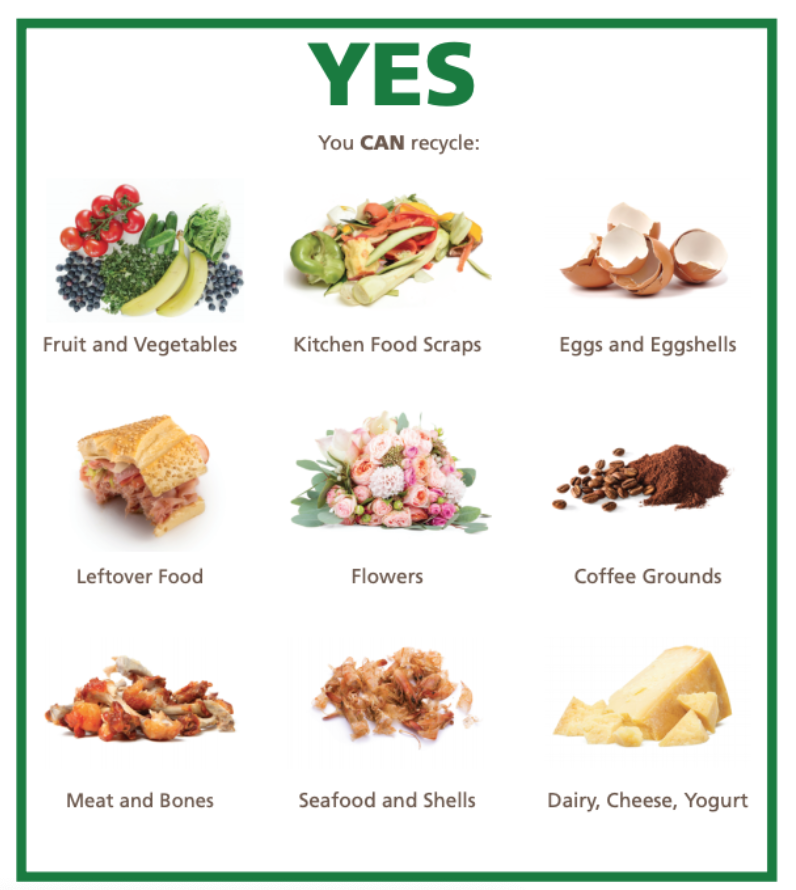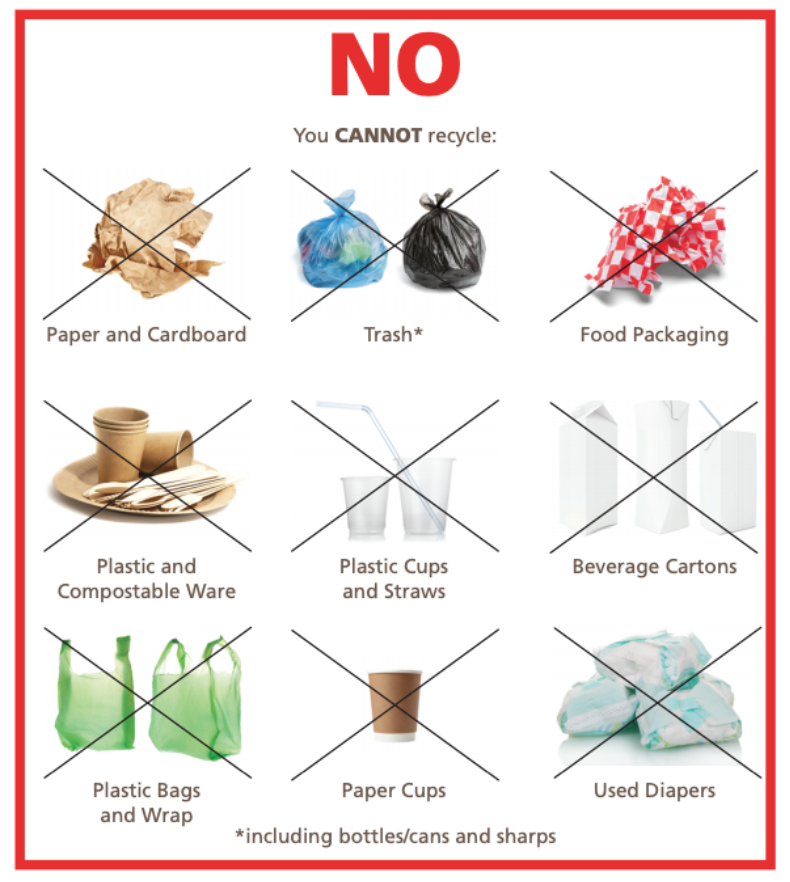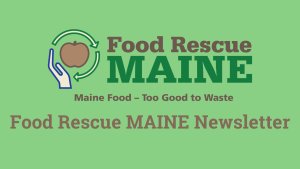Food Recycling – What Is It?
The Mitchell Center’s Maine Food Waste Solution focuses not only on food recycling, but on food recovery as a whole. In order to recover food effectively, we adhere to the food recovery hierarchy (see figure below). The food recovery hierarchy is a process that allows us to use food at every stage of its life- first reduce unwanted food, then feed hungry people, then feed animals, then compost (food recycling), and finally dispose of non-compostable items in landfills.
Food recycling is the composting step of the food recovery hierarchy. Any leftover food scraps that are no longer edible to humans and animals are composted so that eventually the nutrients can be returned to the soil. This process mimics the cyclical manner of sustainability- compost helps crops to grow, crops become food for people and animals, leftover food is composted, and then the cycle can continue.

Maine Food Recovery Hierarchy
Reduce Unwanted Food
- Inventory grocery stock/pantry
- Buy and cook only what you need
- Conduct a wasted food audit
- Use leftovers
Feed Hungry People:
- Donate to food banks
- Partner with organizations that collect and distribute perishable food
Feed Animals
- Contact local farms to see if they can use the scraps
Compost or Convert to Fuel
Dispose
Why Should I Care?
According to the US Department of Agriculture (USDA), 40% of food produced is never eaten – $4 out of every $10 spent on food – approximately 219 pounds of food per person. Maine’s wasted food is costly. There are economic costs: the direct cost of food loss plus related costs for water, labor, energy and soil wasted on uneaten food, social costs: the highest rate of food insecurity in New England with 1 in 5 Maine children being food insecure and 1 in 8 adults; and environmental costs: negatively impacting our natural resources and contributing to climate change (if wasted food were a country it would be the third-largest emitter of greenhouse gases).
By reducing your wasted food using the food hierarchy system, you can save money, help people in your community that are struggling with food insecurity, and help protect our environment by lowering greenhouse gas emissions and keeping wasted food out of landfills.
28% of household bagged garbage is food alone—making it the single largest source of household garbage going to landfills. In 2019, the Mitchell Center for Sustainability Solutions began a six solution plan for ending wasted food in Maine with a focus on the triple bottom line– the social, economic, and environmental benefits of reducing wasted food in the state of Maine. The Maine Food Waste Solution emphasizes the idea that food is beneficial at all stages of its life- even when we can no longer eat it. When food has reached a stage in which it is no longer able to feed people and animals, it can still be recycled to feed the soil. By recycling and composting our food scraps, Maine residents can be assured that these nutrients are being returned back to the state that they love.
How to Get Started
Are you finding yourself getting excited about food recycling but have no idea where to begin? On your own, food recycling can be a big undertaking- there are a million different sources telling you how to do it, and it may feel like just one more thing in your already hectic schedule. We know that nothing in this world is one-size-fits-all, so we have included two different routes that you may decide to take when fitting this process to your individual needs.
For the Quick and Simple
For many of us, taking on composting may seem like just one more thing to add to our busy lives. However, there are a number of options available(depending on your location) that can make food recycling as quick and painless as possible.
There are two main options for a quick and simple solution to composting: bringing your food scraps to a designated drop-off location to be composted there, or a curbside pickup service that takes care of your food scraps for you. There are three basic steps for each of these options:
- Collect your food each week for disposal in a container with a lid. Some places may provide a container for you, but a lidded 5 gallon bucket will do the trick. Simply collect your food scraps every day either on your kitchen counter or even in the freezer if you would prefer (see Composting Do’s and Don’ts).
- Bring your bucket to a disposal site/leave the bucket outside for your curbside pickup service. Usually the containers can be emptied on a weekly or biweekly basis; however, depending on how much wasted food your household creates, you may need to adjust the amount of times that you empty your container. When the container is full, either bring it to your local drop-off location or take advantage of a curbside pickup service(see Drop-off Locations and Curbside Pickup Options).
- When your bucket is empty again, simply rinse, dry, and repeat. After you have recycled your food scraps, make sure that you thoroughly rinse your bucket, lay it on its side to dry, and then work on filling it up again!
For the Hobbyist
If food recycling is something that you would like to consider doing as a hobby or DIY project, there are a few different ways to begin composting in your own backyard.
EPA links to help you get started
Items you can recycle:
- Fruit and vegetables
- Kitchen food scraps
- Eggs and eggshells
- Leftover food
- Flowers
- Coffee grounds
- Meat and bones*
- Seafood and shells*
- Dairy, cheese, and yogurt*


Items you cannot recycle:
- Paper and cardboard
- Trash
- Food packaging
- Plastic and compostable ware
- Plastic cups and straws
- Beverage cartons
- Plastic bags and wraps
- Paper cups
- Used diapers
Common Mistakes With Food Recycling
Diapers
Conventional diapers are not biodegradable or compostable, and the human excrement in diapers presents a biohazard. To properly dispose of diapers, flush fecal matter down the toilet, fold the diaper up, and dispose of it with your trash.
To learn more about alternative diaper options and disposal techniques, click here
Tea Bags
Because tea bags often contain microplastics, make sure to dispose of the tea bag itself, any staples, tags, and packaging in the garbage first, and then you may throw the contents of the bag into the compost.
Coffee Filters
While coffee filters cannot be composted, you can minimize your waste by thoroughly rinsing and using them more than once, opting for a recycled or unbleached coffee filter, or even by buying a reusable metal coffee filter compatible with your coffee maker.
Paper Bags
Brown paper bags can be shredded and used in compost as brown material. However, ONLY plain brown paper bags can be composted. Any bags with ink, a thin layer of plastic or metal, a water-resistant or chemical coating, or bags coated in a non-compostable waste can be composted. Because composting brown paper bags is such a selective process, it is often safer to recycle them with your other paper products. (Learn how to identify compostable paper bags).
Food Wrappers
Food wrappers cannot be composted because they often have a protective coating on them that can contain harmful chemicals such as PFAS (click here to learn more about PFAS). At some point, we hope to have an identifier on wrappers like these that are coated so that in the future, food wrappers can be composted, but for now, simply dispose of these with your trash.
“Compostable” Ware
Compostable ware can include anything from cups to utensils. These products are marketed as compostable; however, they often contain straw AND even some microplastics. When composted, this straw does not process. Please dispose of compostable ware with your garbage.
Resources
There are countless resources on the internet to educate and help you to take action against wasted food in your home and business. While having so many amazing resources is a great thing, it can be overwhelming to begin, and difficult to decide what to listen to. For this reason, we have included a list of action and education tools to make your life easier.
- Discover the Nation’s BEST Leftover Food Recipes
- Dinner Party Calculator: Calculate How Much Food You Really Need
- Need Help Meal Prepping? We’ll Do it For You
- How Much Food Do You Really Waste? Take This Quiz
The following resources will bring awareness to the problems that come with untapped food potential, and the possibilities that come with reducing wasted food through the stories of others taking on this challenge:
- Why Are People Malnourished in the Richest Country on Earth?
- Shocking Truths About What We Eat- Food, Inc.
- Learn How to Eat a Plant-Based Diet- Forks Over Knives
- 13 Best Food Documentaries to Stream in 2019
- Five Films on Food Waste and Hunger
Maine Compost Drop-Off Locations
Mitchell Center Pilot Communities Drop-off Locations:
- Winslow- Parking lot of the Winslow Public Library, 136 Halifax St, Winslow, ME 04901
- Waterville- Drop-off location TBD
- (Readfield/Fayette/Wayne)- Drop-off location TBD
Portland
- Riverside Recycling Site(910 Riverside St, Portland, ME 04103)
- North Garden(195 North St, Portland, ME 04101)
- Clark Garden(This garden is on the corner of Clark Street and Salem Street in Portland, ME)
- Boyd Garden(2 Boyd St, Portland, ME 04101)
- Douglas Garden
For a more complete list of composting locations, click here.
Composting Curbside Pickup Options:
- Scrap Dogs– Scrap Dogs is based out of Rockland, but they offer pick up services from Belfast to Thomaston, and most places in between. Click here to learn more.
- Garbage to Garden– Garbage to Garden serves residents of Bath, Brunswick, Cape Elizabeth, Cumberland, Falmouth, Portland, South Portland, Westbrook, and Yarmouth. Click here to learn more.
- We Compost It!– We Compost It! serves Brunswick, Portland, and Kennebunk.



